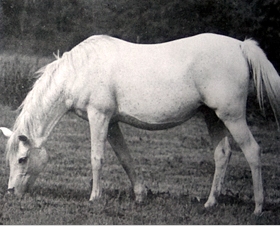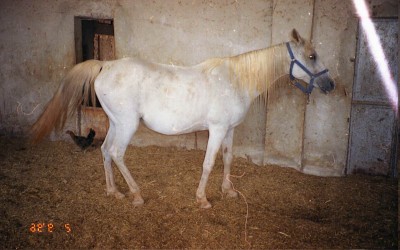The “Bourbon-Parma”
If you haven’t already done so, check out the overview article by the late Carol Lyons, on “Drissula, One of a Kind”. Born in 1941, Drissula (Sultan x Ydrissa by Antez) is the only asil progenitor for the Ma’naghi Sbayli line of *Haidee, who was bred by the Sba’ah Bedouins and was imported to the UK in 1874. I already mentioned my soft spot for this strain.
Some thirty five years ago, when my father asked the late Moussa de Freije, one of the foremost Lebanese authorities on Arabian horses, about why he held a particular M’anaqiyah Sbayliyah mare in such high esteem, the response of the French-educated Mr. de Freije was: “She is a Bourbon-Parma”, in reference to one of Europe’s most noble and blue-blooded dynasties.
While all Ma’naqi Sbayli horses eventually go back to one marbat (Bedouin stud), that of Ibn Sbayyil of the ‘Ajlan clan from the Rasalin section of the Sba’ah Bedouin tribe, who acquired the orginal Ma’naqiyah Hudrujiyah and, in time, gave her his name, not all Ma’naqi Sbaili marabet which subsequently branched out of his marbat were held in equal esteem. Even within the same tribe, levels of prestige and reputation associated with each marbat varied over time, and the fortunes of each marbat rose and fell with its mares merits in the desert warfare activities, the ghazawat (singular, ghazu).
In the first half of the twentieth century, the most reputable and respected of these Ma’naqi Sbayli marabet was that of Zudghum al-Mijlad (of the leading family of the ‘Ajlan clan of the Rasalin section of the Sba’ah tribe). He was a close relative to the original Ibn Sbayyil, and his marbat came to be known as Ma’naqiyat Zudghum.
What marbat *Haidee came from is not recorded. All we know is that she was purchased from Sba’ah tribe, the general source of this strain, and that her sire was from the same strain.
Below is the photo of a mare from another Ma’naqi Sbayli marbat, that of Abu Tarbush, so named because it was owned by (non-Bedouin) members of a sufi order in the middle Euphrates valley. These sufis, who wore their characteristic red hat (the tarbush in Arabic) seem to have obtained their horses from the Sba’ah Bedouins, and their marbat became known as Ma’naqi Tarbush. I took the photo in 1996 at the stud of Kamal Abdul Khaliq, who owned the mare.


A *stallion on my web site is of this line, Ma’naghi Sbayli. I always felt he had to be related to Haleb, as they showed a simular beauty. A tall horse and fun to ride. He was good to his foals, they always managed to get into his area. His foals are exceptional, one mare is out of Atah.
* several photo’s – the brown bay
They should be related indeed: Haidee (1869) was from the Sba’ah tribe, and so was *Haleb (1901), with fourty years difference. According to Bedouin lore, only one mare from that strain came to the Sba’ah, maybe in the 1820s and all Ma’naqi Sbaylis trace back to her. I would like to some DNA testing to verify that.
“According to Bedouin lore, only one mare from that strain came to the Sba’ah, maybe in the 1820s and all Ma’naqi Sbaylis trace back to her. I would like to some DNA testing to verify that.”
Another project!!
Yup, and there are just a little too many of these nowadays.. I need to focus on just a few, I am spread too thin, or I need to start recruiting!
Interesting article. It is realy great to have so many arabian eksperts in one place like this blog.
Can you said opinion about this stalions(these horses are one special arabian breed).
http://borickiarapskikonj.4umer.com/linije-pastuha-f8/kuhaylan-zaid-t12.htm
http://borickiarapskikonj.4umer.com/linije-pastuha-f8/
http://borickiarapskikonj.4umer.com/linije-pastuha-f8/saabih-t19.htm
The original Bowling study found Haidee to have a unique haplotype among all those studied at the time (assigned the sequential identification of A24). As far as I can determine, subsequent research to identify a few additional lines, and the work done on the Polish lines (http://www.ncbi.nlm.nih.gov/pmc/articles/PMC2682809/pdf/1297-9686-39-5-609.pdf) have not found any other foundation mares that match that type.
Anita
Dear Anita: So if Haidee is completely different, then her line should be even more important to preserve simply as an outcross..You know the great arabian sires of history were Muniqis- The Darley arabian, Obayan of Babolna, Haleb of course. and later on Zamal of the Hearsts.
Best wishes
Bruce Peek
Wasn’t the Blunt’s FErida also included in the mtDNA study. She was a Ma’naqiyah Sbayliyah too
Yes, the Blunt’s Ferida was in the Bowlings’ study. Ferida’s haplotype came up as different (sequence number A10). The two mares (Ferida and Haidee) have the same historic strain, but at some past (“pre-historic” might apply) time they were from different source mares.
The Bowling study found several such situations where horses of the same historic strain identification had different haplotypes. And they found that several with different historic strain identification actually traced to the same “pre-historic” source.
Anita,
That’s interesting. If I understand your post correctly that would mean that Ferida and Haidee were not sisters? I know Edouard has said more than once that the 2 mares were thought to be sisters that had each gone to different tribes which was why Haidee was considered Hadrujiyah and Ferida S’bailiyah.
Terri,
I am out of town until Wed. and so don’t have all my reference materials with me. When I return I’ll look at the Bowling paper and post her about the specific number of sites where the two haplotypes differ. If Ambar or Michael have a moment, either could fill in for me. My recollection is that they are sufficiently different that the mares could not descend from the same female ancestress, at least within several thousand years. This does not, in any way, alter the information on their tribal origins.
Terri, I don’t recall ever saying that Haidee and Ferida were sisters.
What I have certainly said and continue to say, is that Ma’naqi Hudruji is the larger family, and that the family of Ma’naqi Sbayli is a derivative branch of it.
There were several Ma’naqiyah Hudrujiyah mares in the desert at some point, and only one of these became known as the particular mare Ma’naqiyah Hudrujiyah mare of Ibn Sbayil also known as Ma’naqiyah Sbayliyah for short. The other Ma’naqiyah Hudrujiyah mares still retain their names, until the present day.
According to Bedouin lore, all Ma’naqiyah Sbayliyah mares are said to descent from this one mare, and this would include the two mares imported to the UK, Haidee by Upton and Ferida by the Blunts, which mean they should in theory be having the same DNA haplotype, since they are both recorded as Ma’naqiyah Sbayliyah. However, it seems that they don’t, which raises a lot of questions about the truth of Bedouin tradition on that specific issue of all Ma’naqiyah Sbayliyahy tracing to one mare.
For now, both Haidee and Ferida are recorded as Sbayli, which means they are both Hudruji, because Sbayli is an offshoot of the main Hudruji strain.
Does that make sense?
The strains of the horse bought in the desert by Europeans may not be correct.
i.e. If the guide knows that the buyers are looking for a certain strain,he may ask the buyer to lie about the strain of the horse he is selling ,just to meet the buyer taste.
lately i wrote about this subject and how European Chritians buyers could have been cheated.
All these studies may rely on a lie.
That’s true, and it explains the predominance of the Saqlawi Jadran imports. At some point, every other imported stallion seemed to be a Saqlawi Jadran.
To bo arap
My friend,these sites are in Croatian,according to the Google English translation these horses seems vey interesting.
Could you please ,if you are fluent in Croatian,give us a better translation.Thank you.
This kind of discussion always reminds me of *Lisa (a black Seglawieh without a substrain? how horse trader is that?) but questioning one pedigree doesn’t necessarily imply, still less prove, that all pedigrees are false–different explanations could apply in different cases.
Another reading, which makes biological sense, is that the strain origin legends were actually legends, and at a time in history it became a point of belief that all the mares of Ibn Sbayil descended from a single mare he owned in the past. In other words, strains descend from groups of mares, not single individuals. The story of Adam and Eve would be analogous.
As to the A24 mtDNA haplotype, it was found in two families: Haidee and Lewis Payne’s Saudi mare *Hamra Johara, discussed here some time back.
Michael,
Am always reminded when you speak or write of your nature, simply, informed understanding of what it is you do, and the grace you do it in.
with respect, Jackson
Yes, we have the legend that all Arabian horses are from the original mare, bred to her son, who was apparently by the desert wind. If you start there, then all Arabian horses over time just expand from the one mare, perhaps 3000 years ago, and all would share one mitochondrial haplotype. That is obviously untrue, of course.
What we personally have always said is the our horses are representative of what the Bedouin had over 100 years ago, and we want to keep them recognizable in that context. If the horses were good enough for the Bedouin of that time, that is what we want, and what we want to preserve for the future.
And whatever science proves to us about those horses, is simply something more that we know about them, and what made them special to the people who bred them.
Michael, your point is true in general. Still, the transition from Ma’naqi Hudruji to Ma’naqi Sbayli occured at a relatively recent point in time (1820 at the earliest). The mother branch of Hudruji still exists, and there are still some faded accounts of the transmission of the strain through one mare that passed from the Amarat (I think) to the Sba’ah.
At the time the Abbas Pasha Manuscript was being compiled, the strain was still referred to as Ma’naqi Hudrugi from Ibn Sbayyil, and hadn’t yet coaslesed into the new strain of Ma’naqi Sbayli, which means that in 1850 that transition was still relatively fresh.
That does not mean that there was only one original Sbayliyah mare, as you point out. It just means the event belongs more to history than legend..
According to Blunt records, Ferida was a Managhieh Sbeylieh of the Shammar tribe in Mesopotamia, not the Sebaah. There is also Wilfrid Blunt’s 1897 comment that “Ferida’s stock though excellent should not give sires to the stud, Ferida’s pedigree having been insufficiently ascertained.” See The Crabbet Arabian Stud, Its History and Influence, p. 227. I don’t know what that means, or whether Blunt still held that view more than a decade later when he bred Fakreddin, Fejr, and *Ferda from Ferida’s daughter Feluka.
Ferida was imported to England in May of 1891 and as of 1897 Ferida’s excellent stock consisted of just three foals, all by Mesaoud: an 1892 daughter Fezara, an 1894 colt Farfar, and an 1896 colt Franjistan. Through 1904, there would be five more full siblings born from the Mesaoud x Ferida cross.
I will add that the GSB records a breeding of Ferida’s son Farsang to the Blunts’ mare Jemeyza (Mesaoud x Jeneyna, by Azrek x Jerboa) in 1903.
Farsang was sold at the 15th Crabbet sale on July 4, 1903 for exportation to South Africa. Jemeyza was sold in the spring of 1904 to Portugal. Although bred to just one mare who seems to have been sold before foaling, Farsang was ostensibly a Crabbet sire from Ferida’s stock.